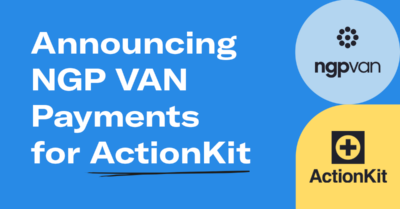5 Tips to Avoid Spam Traps for Your Political Campaign

Spam traps can wreak havoc on your political email campaigns. These email addresses may go unnoticed on your email lists before derailing the campaign and costing you fundraising dollars. By inadvertently sending emails to a spam trap, you risk lowering your deliverability rate and, in turn, other email, fundraising, and supporter engagement metrics.
There are steps you can take to prevent falling victim to one of these traps. First, it’s important to understand the basics:
What is a Spam Trap?
A spam trap is an email address used by email service providers (ESP) and anti-spam services to identify senders with poor data quality practices. If you send an email to a spam trap, the sender assumes that you have a non-opted-in and/or confirmed list, bought email addresses and/or appended email data, or you have poor list hygiene practices.
Types of Spam Traps
When you trigger a spam trap, it can impact your campaign in different ways depending on what type of trap it is. The two types include:
- Pristine Trap: A pristine spam trap, also called “honey pot” and “true” traps, are brand new email addresses that have never been used as active email addresses before. This means that they could not belong to someone who intentionally registered for your list and can only be added to lists by being misspelled, scraped from a website, or bought. If you trigger a pristine trap, expect to have significant deliverability issues or even see your email program shut down.
- Recycled: The email addresses used in these traps were once active addresses used by real individuals. However, they became inactive, resulting in a hard bounce indicating that they should be removed from lists. If these addresses are not removed after a period of time, they are turned into a spam trap.
Understanding how each type of spam trap originates will help you take the precautions needed to avoid them to maintain your base of online supporters.
The Effects of Spam Traps
As mentioned, the impact of spam traps on your email campaign can vary by the type of trap you trigger, as well as how many are triggered and through which ESP. Typically, the negative consequences of a triggered spam trap include:
- A lowered sending reputation, which can also lower your inbox placement
- The domain and IPs you send from being blacklisted
- The ESP blocking, throttling, or quarantining emails you send
- Diminished open and click-through rates
None of these are things you want to see in an email marketing campaign. For political campaigns specifically, the impact of spam traps can decrease supporter engagement and fundraising metrics significantly. Not to mention it takes a significant amount of time and effortt to rebuild your email program after triggering spam traps. And with a limited amount of time and resources available during the campaign cycle, every minute and dollar raised counts. To limit your exposure to spam traps in the first place, you’ll need to carefully follow best practices to manage your lists.
How to Avoid Political Spam Traps
Because there are different kinds of spam traps, there are different ways you might encounter these traps. For example, while maintaining stringent hygiene practices for your email list can shield you from recycled spam traps, it won’t always protect against pristine traps.
Avoiding certain practices and putting safeguards in place can help limit the likelihood of your campaign triggering a spam trap and costing your campaign time and money that you don’t want to lose. Here are four tips to implement into your email list building and maintenance processes:
1. Use Confirmed Opt-Ins
Confirmed opt-ins are the only way to guarantee that a spam trap doesn’t get added to your organically built email list. To do this, you’ll send emails to each new subscriber asking them to click a link and confirm their subscription. If the recipient does not confirm their subscription, they’ll be unsubscribed.
Spam traps almost never click links. So, you can rest assured that any email addresses that confirm their subscription are likely active addresses used by individuals.
Keep in mind that this tactic could slow your email list growth, and a portion of subscribers will forget about or ignore the opt-in email. However, in addition to protecting your email list from spam traps, their confirmation can also indicate that they may be more likely to interact with your campaign’s emails in the future too.
2. Monitor and Clean Your Lists
If you want to avoid the side effects associated with using confirmed opt-ins, the next best alternative is to simply keep a close eye on your list growth statistics within your email software. Watch out for “red flags” that might warn you of spam traps, such as:
- Hard bounces
- Complaints
- Unsubscribes
Most email marketing platforms will allow you to easily monitor those metrics so you can make adjustments if needed to help protect your political campaign’s email program. If you see a high volume of any of those three actions from certain web pages, hand-typed imports, offline list-building activities, explore the data further to see how and why the issues are occurring. If you notice any users showing no interaction for a long period of time, it may be time to send them one last email to engage the subscriber before manually unsubscribing them. If they aren’t engaging with your emails, they are dead weight at best, and a spam trap at worst.
3. Use a Welcome Series
A welcome series serves to remind subscribers of how they got on your email list and what they can expect from your campaign. This eases them into your email program slowly, rather than sending a barrage of unexpected emails. These welcome series tend to perform well by interacting with your campaign’s supporters immediately after they subscribe to your list with engaging content.
Just as you would audit your email campaign’s overall performance, keep an eye on performance metrics for your welcome series like hard bounces, complaints, and unsubscribes to monitor your program’s success. If there are specific emails in your series that lead to a higher share of detrimental metrics, consider editing or replacing it to help retain your supporters and protect your ability to encourage supporters to take action for your campaign.
4. Never Buy a List
One of the ways a spam trap could end up on your email list is through swapped, purchased, or appended lists. While you can practice good list hygiene, receiving a list from external sources means that you are rolling the dice and trusting that their list doesn’t have any problems.
Because you are relying on the source of the email list to have good data practices, the risks are significant. It’s best to completely avoid ever purchasing a list. No one likes spam, and many email software providers, including us, regularly monitor and review spam complaints and reports to help curb those who abuse the system.
If you purchase a list and encounter problems, those issues will be severe and leave your organization without many options to solve them. It can take months to fix these issues (particularly if a pristine trap was triggered), causing your email program and fundraising efforts to suffer.
5. Set Up SPF & DKIM Records
Before you launch your email program for your political campaign, you should configure your SPF (Sender Policy Framework) and DKIM (DomainKeys Identified Mail) records to help ensure the legitimacy and deliverability of your emails. SPF helps authorize which email servers are authorized to send emails on behalf of your domain, reducing the chances of your campaign emails being marked as spam. DKIM places a “virtual signature” on your emails, allowing recipients to verify that your messages haven’t been tampered with. By proactively setting up SPF and DKIM records, you help increase the likelihood of your campaign’s emails reaching your intended audience.
Protect Your Campaign from the Negative Effects of Spam Traps
Triggering a spam trap can be detrimental to your email campaign, setting you back by weeks or even months and costing you valuable fundraising dollars and supporter engagement. But by following the steps we laid out here and keeping an eye out for suspicious activity, you can help prevent the harm done by spam traps and launch a winning campaign.
NGP VAN’s best-in-class digital tools can help you monitor email marketing metrics, craft automated email series to welcome new subscribers, and so much more. Trusted by thousands of Democratic and progressive campaigns and causes, our software continues to help power change in communities nationwide.



